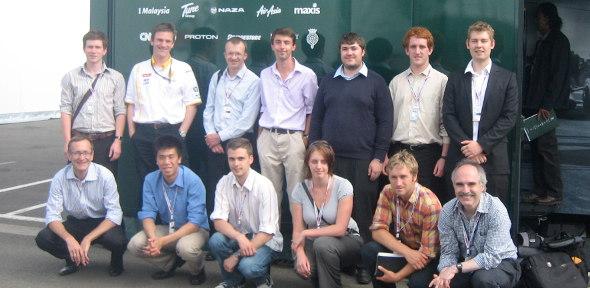
On the Thursday before this year's British Grand Prix seven recently graduated Cambridge Engineering students travelled over to Silverstone to present the findings of their final year projects to a specially invited audience of F1 engineers and motorsport journalists in the Lotus Racing motor home.
The projects were all co-supervised by Professor Tony Purnell, a Royal Academy of Engineering Visiting Professor at the Department of Engineering, with other members of Department's teaching staff (Professor Bill Dawes, Dr David Cole and Dr Geoff Parks).
Professor Purnell was until recently a technical consultant to the FIA and through this link he has proposed a number of final year projects in which the students investigate the impact of potential changes to the technology and regulations governing F1 races.
The students and their projects:
Robert Woolley: "A Multi-Car Simulator for the Evaluation of Technical Rule Changes and Their Effect on Races"
Racing cars interact with each other, they create turbulent wakes, upwash and downwash in the airstream, all of which slows down the cars that follow around the bends, and if they are close enough speeds them up on the straights. A surface layer of rubber is laid on the tarmac improving the grip of the follower, but this sheds shards of rubber and flicks dirt to the less used part of the circuit. This less used part is critical for overtaking, one of the most hazardous moves in motor racing. Robert simulated these effects producing a tool to help regulators see the consequence of rule changes on the way races are likely to unfold.
Mark Graham: "How Far Can One Go with Kinetic Energy Recovery Systems (KERS)?"
KERS systems are back in Formula One in 2011, and consideration is being given to taking away many of the constraints on the path-finding systems being used for a new set of regulations in 2013. Just how far could one go? Ban brakes and just rely on KERS retardation, or would this be dangerous? Have no limits to the energy store, or would the system be too heavy? Go with four wheel drive/braking systems? What would the ultimate KERS system look like? One that pays for itself in terms of extra weight, complexity and aerodynamic disadvantage? Mark made significant steps in answering these questions looking very much from the point of view of the car as one holistic system.
Ho-On To: "The Effect of Fuel Limitations on Entertainment in F1 Races"
Fuel mileage sells cars, so the manufacturers involved in Formula One like the marketing possibilities of races being run with a set quantity of fuel making it demanding to finish the race and rewarding performance through efficiency gain. Fans fear that this might lead to economy runs. What's the truth? Ho-On used simple modelling to investigate quite a complex problem, with very compelling results indicating that the fans may well be quite wrong, but only if the regulator gets the fuel limits right.
Sean Hale: "Optimisation of Car Set-Up"
Today's race professionals use their intuition and experience to find a good balance of settings for a given circuit. Sean showed how in the future they may be able to use advanced optimisation algorithms to find the best settings. To go faster one needs the right gear ratios, choice of brakes, wing settings, damper settings, inertia settings, springs, bump rubbers, toe, camber,... the real list is even longer. These can all be modelled effectively using lap time simulation software, but with so many choices what is the best set-up possible? Using advanced optimisation algorithms Sean managed to give a good steer as to how race professionals might find this Eldorado deterministically, rather than relying on the intuition and experience base used today.
Tim Johns, Simon Colliss and Matt Jones: "Use of Lateral Aerodynamic Devices to Improve Overtaking"
Robert Woolley's simulator shows clearly how cars affect one another with today's Formula One rules, but how might the rules be changed to make these interactions more benign or perhaps even exaggerate them to make races more entertaining? Tim, Simon and Matt investigated the idea of lateral 'steer' devices (rudders rather than wings) to deliver these objectives. Simon looked at the aerodynamics of a car using such a device leading to a recommendation for a viable configuration; Matt checked to see if the vehicle dynamics were stable and what changes might be needed; and Tim put it all together to explore the effect on the way the races would unfold using this 'Department of Engineering' novel solution to better overtaking and closer races.
Also in the party from the Department were Ned Carpenter and Sarah Fern, third year students who will be doing follow-on projects in the coming year. The group were given a tour of the Lotus Racing garage and welcomed by Mike Gascoyne, Chief Technical Officer for Lotus Racing and an alumnus of the Department. Another alumnus of the Department, James Allison, the Technical Director of Renault F1, was in the audience.
Tony Purnell commented: "Cambridge has rather a good track record as regards Formula One with no less than four of the twelve Team Technical Directors being former students, and there are many more waiting in the wings. To be able to actively engage present students with former ones in perhaps the ultimate engineer's playpen that is Formula One is quite a privilege and will only strengthen this Cambridge-Formula One relationship in the coming years."

